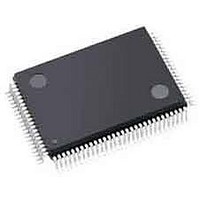LFXP3C-3TN100I Lattice, LFXP3C-3TN100I Datasheet - Page 163

LFXP3C-3TN100I
Manufacturer Part Number
LFXP3C-3TN100I
Description
FPGA - Field Programmable Gate Array 3.1K LUTs 62 IO 1.8/ 2.5/3.3V -3 Spd I
Manufacturer
Lattice
Specifications of LFXP3C-3TN100I
Number Of Programmable I/os
62
Data Ram Size
55296
Supply Voltage (max)
3.465 V
Maximum Operating Temperature
+ 100 C
Minimum Operating Temperature
- 40 C
Mounting Style
SMD/SMT
Supply Voltage (min)
1.71 V
Package / Case
TQFP-100
Package
100TQFP
Family Name
LatticeXP
Device Logic Units
3000
Maximum Internal Frequency
320 MHz
Typical Operating Supply Voltage
1.8|2.5|3.3 V
Maximum Number Of User I/os
62
Ram Bits
55296
Re-programmability Support
Yes
Lead Free Status / RoHS Status
Lead free / RoHS Compliant
Available stocks
Company
Part Number
Manufacturer
Quantity
Price
Company:
Part Number:
LFXP3C-3TN100I
Manufacturer:
Lattice Semiconductor Corporation
Quantity:
10 000
- Current page: 163 of 397
- Download datasheet (10Mb)
LatticeECP/EC and LatticeXP
Lattice Semiconductor
sysIO Usage Guide
Appendix C. sysIO Attributes Using Preference File (ASCII File)
You can also enter the sysIO attributes directly in the preference (.prf) file as sysIO buffer preferences. The PRF file
is an ASCII file containing two sections: a schematic section for preferences created by the Mapper or translator,
and a user section for preferences entered by the user. You can write user preferences directly into this file. The
synthesis attributes appear between the schematic start and schematic end of the file. You can enter the sysIO buf-
fer preferences after the schematic end line using the preference file syntax. Below are a list of sysIO buffer prefer-
ence syntax and examples.
IOBUF
This preference is used to assign the attribute IO_TYPE, PULLMODE, SLEWRATE and DRIVE.
Syntax
IOBUF [ALLPORTS | PORT <port_name> | GROUP <group_name>] (keyword=<value>)+;
where:
<port_name> = These are not the actual top-level port names, but should be the signal name attached to the port.
PIOs in the physical design (.ncd) file are named using this convention. Any multiple listings or wildcarding should
be done using GROUPs
Keyword = IO_TYPE, OPENDRAIN, DRIVE, PULLMODE, PCICLAMP, SLEWRATE.
Example
IOBUF PORT "port1" IO_TYPE=LVTTL33 OPENDRAIN=ON DRIVE=8 PULLMODE=UP
PCICLAMP =OFF SLEWRATE=FAST;
DEFINE GROUP "bank1" "in*" "out_[0-31]";
IOBUF GROUP "bank1" IO_TYPE=SSTL18_II;
LOCATE
When this preference is applied to a specified component it places the component at a specified site and locks the
component to the site. If applied to a specified macro instance it places the macro’s reference component at a
specified site, places all of the macro’s pre-placed components (that is, all components that were placed in the
macro’s library file) in sites relative to the reference component, and locks all of these placed components at their
sites. This can also be applied to a specified PGROUP.
Syntax
LOCATE [COMP <comp_name> | MACRO <macro_name>] SITE <site_name>;
LOCATE PGROUP <pgroup_name> [SITE <site_name>; | REGION <region_name>;]
LOCATE PGROUP <pgroup_name> RANGE <site_1> [<site_2> | <count>] [<direction>] | RANGE <chip_side>
[<direction>];
LOCATE BUS < bus_name> ROW|COL <number>;
<bus_name> := string
<number> := integer
Note: If the comp_name, macro_name, or site_name begins with anything other than an alpha character (for exam-
ple, “11C7”), you must enclose the name in quotes. Wildcard expressions are allowed in <comp_name>.
Example
This command places the port Clk0 on the site A4:
8-23
Related parts for LFXP3C-3TN100I
Image
Part Number
Description
Manufacturer
Datasheet
Request
R

Part Number:
Description:
FPGA - Field Programmable Gate Array 3.1K LUTs 136 IO 1.8 /2.5/3.3V -3 Spd I
Manufacturer:
Lattice

Part Number:
Description:
FPGA - Field Programmable Gate Array 3.1K LUTs 62 IO 1.8/ 2.5/3.3V -3 Spd I
Manufacturer:
Lattice

Part Number:
Description:
FPGA - Field Programmable Gate Array 3.1K LUTs 136 IO 1.8 /2.5/3.3V -3 Spd
Manufacturer:
Lattice

Part Number:
Description:
FPGA - Field Programmable Gate Array 3.1K LUTs 100 I/O 1.8/2.5/3.3V -3 Spd
Manufacturer:
Lattice
Datasheet:

Part Number:
Description:
FPGA - Field Programmable Gate Array 3.1K LUTS 100 I/O
Manufacturer:
Lattice
Datasheet:

Part Number:
Description:
FPGA - Field Programmable Gate Array 3.1K LUTS 136 I/O
Manufacturer:
Lattice
Datasheet:

Part Number:
Description:
FPGA - Field Programmable Gate Array 3.1K LUTs 100 I/O 1.8/2.5/3.3V -4 Spd
Manufacturer:
Lattice
Datasheet:

Part Number:
Description:
FPGA - Field Programmable Gate Array 3.1K LUTS 62 I/O
Manufacturer:
Lattice
Datasheet:

Part Number:
Description:
FPGA - Field Programmable Gate Array 3.1K LUTs 62 I/O 1.8/2.5/3.3V -4 Spd
Manufacturer:
Lattice
Datasheet:

Part Number:
Description:
FPGA - Field Programmable Gate Array 3.1K LUTS 62 I/O
Manufacturer:
Lattice
Datasheet:

Part Number:
Description:
FPGA - Field Programmable Gate Array 3.1K LUTs 100 I/O 1.8/2.5/3.3V IND
Manufacturer:
Lattice
Datasheet:

Part Number:
Description:
FPGA, 1.8V FLASH, INSTANT ON, SMD
Manufacturer:
LATTICE SEMICONDUCTOR
Datasheet:
Part Number:
Description:
FPGA LatticeXP Family 3000 Cells 320MHz 130nm (CMOS) Technology 1.8V/2.5V/3.3V 208-Pin PQFP Tray
Manufacturer:
LATTICE SEMICONDUCTOR
Datasheet:
Part Number:
Description:
FPGA LatticeXP Family 3000 Cells 320MHz 130nm (CMOS) Technology 1.8V/2.5V/3.3V 144-Pin TQFP Tray
Manufacturer:
LATTICE SEMICONDUCTOR
Datasheet:
Part Number:
Description:
FPGA LatticeXP Family 3000 Cells 360MHz 130nm (CMOS) Technology 1.8V/2.5V/3.3V 100-Pin TQFP Tray
Manufacturer:
LATTICE SEMICONDUCTOR
Datasheet:











